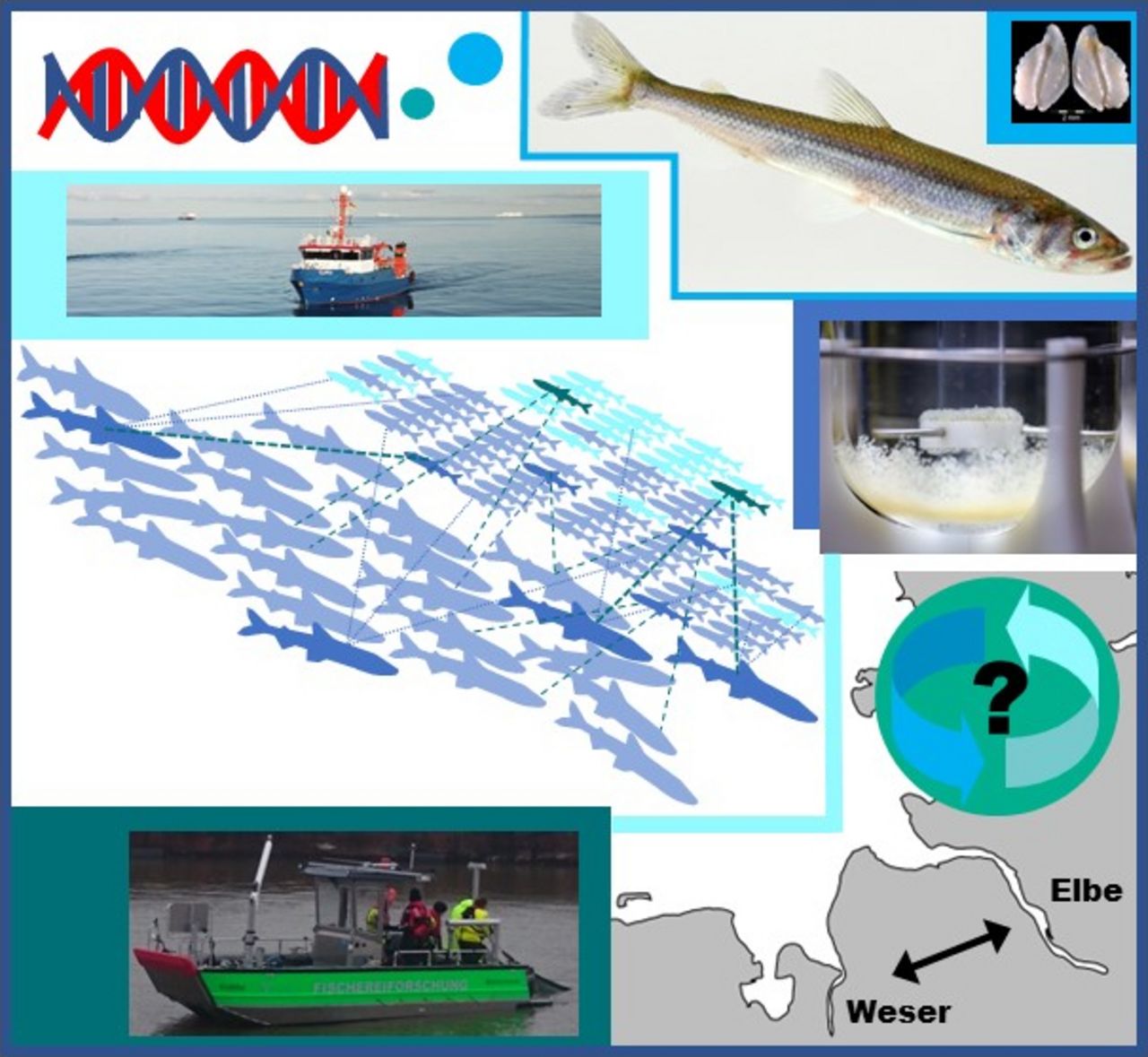Project
Genetic Methods for Monitoring of fish stocks

Development of new genetic methods for monitoring fish stocks using the example of the European smelt (Osmerus eperlanus)
Current methods used for stock size surveys in fisheries monitoring are invasive and contribute to environmental stresses and strains. A genetic approach based on relationship patterns within stocks should bring relief.
Background and Objective
Careful and sustainable management of fish stocks requires regular monitoring in order to be able to estimate current sizes and further developments. Complex, demographic models are built to forecast future stock developments under different usage scenarios and to state prescient catch quota recommendations. This work is mainly based on the evaluation of information from logbook recordings from commercial fishing as well as on regular research catches. The methods, used to obtain this fisheries research data, are not only labour-intensive, but also invasive, especially since, in addition to the target species, unnecessary bycatch ends up in the nets, when data are collected using classic fishing gear. Furthermore, despite the most careful work, are calculations based on these traditional methods, often subject to great uncertainties; This can result in ecologically and economically relevant misjudgements.
Newer approaches therefore try to use molecular genetic techniques to infer the size of a population by analysing genetic relationships within a sample. Using next-generation sequencing (NGS) methods, so-called SNPs (single nucleotide polymorphisms) can be identified as genome-wide genetic markers, which not only can be used to characterize differences between populations but also to resolve relationships between individuals. In the GenMeMo project, these methods will be used in the so-called CKMR (Close-Kin Mark-Recapture) method, a completely new approach for the estimation of population sizes that is largely independent of fisheries data. In addition, CKMR provides some other parameters that are important for assessing population dynamics, such as fertility and mortality. CKMR has been successfully applied to some marine species in the past. As a method, CKMR offers the potential to supplement and extend traditional methods for recording the structure and dynamics of a population and to replace at least many of the very laborious biological input data. In the GenMeMo project, the genetic method is to be tested for the first time for its applicability to an anadromous and economically relevant migratory fish species of the Elbe and Weser, the European smelt (Osmerus eperlanus). The method is planned to be adapted accordingly and compared to various, classically collected, population-biological parameters for its validation.
Approach
Using the example of the European smelt (Osmerus eperlanus), the central aim of the project deals with the question of whether the population size of an anadromous migratory fish species can also be realistically estimated using the molecular genetic CKMR method. For this purpose, a suitable strategy for the genetic sampling of the stock will need to be developed. In addition to the molecular genetic sampling for the CKMR analyses, population biological parameters are to be collected using traditional methods, which not only enables the results to be validated, but also provides important parameters for species-specific modeling of the population development. Smelt belong to the typical fish fauna in the coastal sea and in the estuaries of the big rivers.
In the Wadden Sea in particular, they play an ecologically important role as predators, but also as prey for larger fish, seabirds and marine mammals. In spring the European smelt, which is native to the North Sea, migrates in large swarms up the estuaries of the German Bight to spawn in the rivers, at which it still is unknown whether smelt prefer to return to their native rivers to spawn. Since this represents important information for sustainable management of the stocks, the genetic markers collected will also be used to investigate whether the stocks native to the North Sea are divided into different, river-specific populations. Here the focus will in particular be laid on the rivers Elbe and Weser. Another important part of the project deals with the development of techniques for the artificial breeding of the smelt. As part of this work package, the artificial reproduction and rearing of the smelt is attempted to be established in order to later be able to investigate the influence of different environmental conditions on the growth of the larvae. These investigations can provide valuable clues as to possible causes for the recent significant decline in smelt populations in some German rivers.
Our Research Questions
- Are the lower reaches of the Weser and Elbe populated by separate smelt populations that evolve independently?
- If so, how do the smelt stocks in the Elbe and Weser estuaries differ with regard to:
o their population sizes?
o their growth and other population parameters (e.g. fertility, condition)?
o their ecological niches (phenotypic plasticity, i.e. non-genetic adaptability; life phases in fresh vs. sea water)?
o the habitats they use or their migration behavior?
- Can it be shown that genetic exchange takes place between populations?
- Can smelt be propagated and raised experimentally?
Thünen-Contact

Involved Thünen-Partners
- Blancke, TinaFI Institute of Fisheries Ecology
- Eschbach, ErikFI Institute of Fisheries Ecology
- Friese, JuliaSF Institute of Sea Fisheries
- Haslob, HolgerSF Institute of Sea Fisheries
- Illing, BjörnFI Institute of Fisheries Ecology
- Möckel, BenitaFI Institute of Fisheries Ecology
- Reiser, StefanFI Institute of Fisheries Ecology
Involved external Thünen-Partners
- Agencia Estatal Consejo Superior de Investigaciones Científicas (CSIC)
(Madrid, Cordoba, Spanien)
Funding Body
-
Federal Office for Agriculture and Food (BLE)
(national, öffentlich)
Duration
1.2022 - 12.2024

![[Translate to English:] [Translate to English:]](/media/_processed_/2/9/csm_Embryo-Exp_Gelege_9F_dpf5-200513111619_c8534a8199.jpg)
![[Translate to English:] [Translate to English:]](/media/_processed_/2/9/csm_Embryo-Exp_Gelege_9F_dpf5-200513111619_9027994d44.jpg)
![[Translate to English:] Logo des Bundesministerium für Ernährung und Landwirtschaft](/media/allgemein/logos/BMEL_Logo.svg)